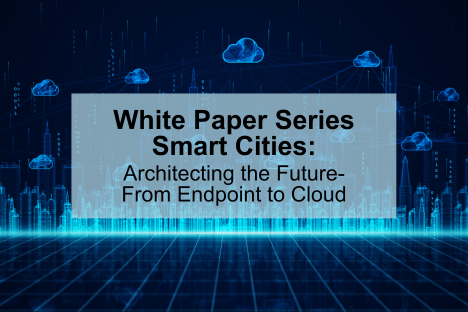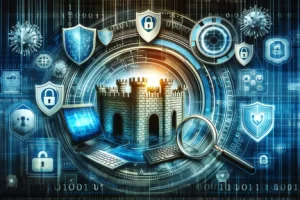Introduction
This White Paper Series aims to provide a comprehensive guideline and framework for stakeholders involved in the planning, development, and management of smart cities, with a focus on resilience, sustainability, and intelligence.
Specific Objectives:
Understand Critical Components:
Objective: To dissect and understand the pivotal components and infrastructures essential to the development and functioning of resilient and sustainable smart cities.
Sub-Objective: Delve into the roles of digital infrastructure, connectivity, data management, and renewable energy integration in smart city development.
Highlight Cybersecurity Importance:
Objective: To underscore the significance of cybersecurity in safeguarding smart cities against a backdrop of evolving cyber threats.
Sub-Objective: Offer insights into creating robust and dynamic cybersecurity frameworks, emphasizing preemptive threat mitigation and data privacy.
Emphasize Sustainable Practices:
Objective: To champion the adoption and integration of sustainability in the planning and operation of smart cities.
Sub-Objective: Illuminate the importance of sustainable energy, transportation, and waste management in promoting urban sustainability and resilience.
Showcase AI & IoT’s Role:
Objective: To delineate the integral role of Artificial Intelligence (AI) and the Internet of Things (IoT) in optimizing city services and functions.
Sub-Objective: Illustrate how AI and IoT contribute to automation, data analysis, and the delivery of personalized city services.
Promote Community Engagement & Inclusion:
Objective: To advocate for citizen participation and inclusion as crucial elements in the development and implementation of smart city initiatives.
Sub-Objective: Discuss strategies for engaging communities in planning and decision-making processes while ensuring widespread digital inclusion.
Foster Collaborative Approaches:
Objective: To encourage collaborations and partnerships among public and private sectors, academia, and non-profits.
Sub-Objective: Provide a roadmap for fostering partnerships that pool resources, expertise, and innovation for smart city projects.
Highlight Continuous Learning & Improvement:
Objective: To stress the importance of continuous assessment, learning, and improvement in smart city initiatives.
Sub-Objective: Outline best practices for staying current with technological advancements and urban planning trends while fostering a culture of innovation.
Develop Human Capital:
Objective: To emphasize the need for investing in human capital development, education, and training.
Sub-Objective: Propose strategies for building a workforce and citizenry that are digitally literate and can effectively engage with smart city technologies.
Through achieving these objectives, the White Paper Series aspires to be a pivotal resource for urban planners, policymakers, technology providers, and other stakeholders in the smart city ecosystem. The Paper seeks not only to guide but to inspire action towards building cities that are not just technologically advanced but are also resilient, sustainable, and inclusive, enhancing the quality of life for all residents in the long term.
Architecting the Future: From Endpoint to Cloud
Overview of Integrated Technologies
When beginning to architect a smart city, it is crucial to consider and integrate a myriad of technologies. Smart cities utilize a mix of interconnected technologies to improve the efficiency of city operations and the quality of life for its citizens. Below is a non-exhaustive list of key technologies typically considered:
1. Internet of Things (IoT) Devices:
Sensors and actuators embedded in urban infrastructure to collect data. Devices like smart meters, wearables, connected cars, and environmental sensors.
2. Data Analytics and Big Data:
Tools and technologies to analyze large volumes of data generated by IoT devices. Big Data platforms help in decision-making and uncovering insights.
3. Cloud Computing:
Provides scalable computing resources, storage, and applications on demand. Supports data analytics, machine learning, and other advanced capabilities.
4. 5G and Advanced Networking:
Offers high-speed connectivity and low latency communication. Essential for real-time applications, like autonomous vehicles and augmented reality.
5. Cybersecurity Solutions:
Ensures the security and privacy of data and infrastructure. Incorporates firewalls, encryption, intrusion detection systems, and other security protocols.
6. Artificial Intelligence and Machine Learning:
Provides capabilities for predictive analytics, automation, and optimization. AI algorithms analyze data patterns and make decisions without human intervention.
7. Blockchain:
Enables secure and transparent transactions. Useful in supply chain management, energy trading, and identity verification.
8. Smart Grids:
Enhances the efficiency and reliability of energy distribution. Incorporates renewable energy sources and energy storage solutions.
9. Integrated Platforms:
Systems that allow different technologies to work together seamlessly. Platforms for smart transportation, waste management, water supply, and public safety.
10. User Interfaces and Applications:
Apps and portals for citizens to access services and information. Provides platforms for communication and engagement with city officials.
11. Geospatial Technology:
GIS (Geographic Information Systems) for mapping and analyzing spatial data. Supports urban planning, emergency response, and resource management.
12. Automation and Robotics:
Automates routine and complex tasks, from traffic control to maintenance of infrastructure. Robotics can be used in surveillance, delivery, and environmental monitoring.
Implementation Considerations:
- Interoperability: Technologies must be compatible and able to work together seamlessly.
- Scalability: Solutions should be able to grow and adapt to changing needs and demands.
- Sustainability: Technologies should be environmentally friendly and economically viable.
- Privacy and Ethics: Implementations must respect citizens’ privacy and comply with ethical standards.
- Public-Private Partnerships: Collaboration between government and private sector is often essential.
- User Engagement: Solutions should be designed with input and feedback from the community.
Successful smart city initiatives often begin with a pilot project focused on a specific technology or application area, then expand and integrate additional technologies over time. Careful planning, stakeholder engagement, and ongoing evaluation and adjustment are crucial for long-term success.
Importance of data security, privacy, and volume handling
- Data Security:
Importance:
•Critical Infrastructure Protection: Smart cities rely heavily on digital infrastructures for various services. A security breach could lead to serious disruptions, affecting utilities, transportation, emergency services, and more.
•Public Trust: Citizens need to trust that their data is safe. Security breaches can erode public confidence in smart city initiatives, making residents less likely to use digital services.
•Financial Loss Prevention: Data breaches can result in significant financial losses due to fines, reparations, or loss of business and investment.
Considerations:
•Encryption: Data should be encrypted both in transit and at rest to protect it from unauthorized access.
•Multi-factor Authentication: Provides an extra layer of security by requiring multiple forms of verification.
•Regular Audits & Updates: Systems should be continually monitored, and security features should be updated regularly to protect against new threats. - Data Privacy:
Importance:
•Legal Compliance: Smart cities must adhere to privacy laws and regulations, like GDPR in Europe or CCPA in California, which impose strict rules on data collection and processing.
•Citizen Autonomy: Residents should have control over their data, including the right to know what data is collected and how it’s used.
•Social Equity: Ensuring that data collection and processing practices don’t discriminate against or harm specific groups or individuals.
Considerations:
•Anonymization: Data should be anonymized to protect individual identities. This involves removing or altering personal information so it can’t be linked back to specific individuals.
•Data Minimization: Collect only the data necessary to provide a service or meet a specific objective.
•Transparency: Clearly communicate with the public about data collection practices and policies. - Volume Handling
Importance:
•Efficiency: Smart cities generate massive amounts of data. Efficient handling is crucial to ensure that data can be processed, analyzed, and utilized in real-time or near-real-time for decision-making.
•Storage: With the volume of data generated, effective storage solutions are necessary to manage costs while ensuring data integrity and accessibility.
•Scalability: As the city grows and evolves, the data infrastructure must be able to scale to accommodate increasing data volumes without performance degradation.
Considerations:
•Edge Computing: Processing data closer to where it is generated reduces latency and bandwidth use, making applications more responsive and efficient.
•Data Warehousing & Lakes: Implement solutions that allow for the secure and organized storage of large datasets, enabling efficient retrieval and analysis.
•Data Life Cycle Management: Implement policies and systems for data retention, archiving, and deletion, ensuring compliance with legal requirements and optimizing storage resources.
In smart city projects, prioritizing data security, privacy, and volume handling is not only about compliance with laws and regulations but also about building trust with citizens and creating a foundation for sustainable, resilient urban development. Each of these elements requires a comprehensive and proactive approach to mitigate risks and maximize the benefits of smart city technologies.
Real-world examples of architecture in smart cities, with Stealth-ISS Direct Involvement
Abu Dhabi- Smart Dubai Initiative
Architecture:
Digital Cloud Platform: Abu Dhabi has invested in robust cloud infrastructure that serves as the backbone for its various smart services, allowing for efficient data storage, processing, and analytics.
Smart Sensors & IoT: An extensive network of sensors and IoT devices have been deployed throughout the city to monitor and manage traffic, utilities, environment, and more.
Blockchain: The emirate is integrating blockchain technology to secure transactions and data, promoting transparency and efficiency in services.
Implementation:
Smart Utilities:
Water Management: IoT devices monitor water usage and distribution in real time, aiding in conservation and leak detection efforts.
Electricity & Energy: Smart grids and meters facilitate efficient energy distribution and consumption monitoring.
Smart Transportation:
Noor Abu Dhabi: This solar project is one of the largest in the world, and AI helps optimize its operation and maintenance.
Smart Traffic Management: AI and IoT devices are used to manage traffic flow, reduce congestion, and improve public transportation.
Public Safety and Security:
Emergency Response: AI-enhanced systems allow for quicker and more efficient responses to emergencies and disasters.
Surveillance System: An integrated system helps in maintaining security and public order, with AI analyzing data for threat detection.
Environment and Sustainability:
Environmental Monitoring: Sensors and AI technologies monitor air and water quality, providing real-time data to both officials and the public.
Waste Management: Smart bins and waste management systems are employed to enhance recycling and reduce waste.
Singapore-Smart Nation Initiative
Architecture:
Smart Sensors and IoT Devices: Singapore extensively utilizes sensors and IoT devices across the city to collect data on traffic, weather, waste management, and more.
Data Analytics: AI and big data analytics are employed to process and analyze the massive volumes of data generated in real time. Digital Identity (SingPass): Residents use a secure, single digital identity to access government services.
Implementation:
Smart Mobility: AI optimizes public transportation and traffic lights and provides real-time traffic information to reduce congestion and improve mobility.
Environmental Monitoring: Sensors and AI track and analyze environmental data to monitor air quality, water levels, and other environmental parameters.
Elderly Care: The initiative implements AI and IoT to support the health and wellbeing of elderly residents through monitoring and telemedicine services.
Azerbaijan – Baku Smart City Project:
Architecture:
Data Centers: Investment in robust data centers provides the necessary infrastructure for hosting and processing large volumes of data efficiently and securely.
Connectivity Infrastructure: Development of high-speed internet and wireless networks ensures seamless connectivity for citizens and IoT devices alike.
Sensor Networks: Deployment of various types of sensors throughout the city facilitates data collection from multiple sources, including traffic, utilities, and environmental factors.
Implementation:
Smart Utilities & Energy:
Energy Efficiency Projects: AI and IoT technologies are incorporated into utility systems to monitor energy consumption and improve efficiency across the city’s buildings and facilities.
Renewable Energy Integration: Smart grids support the inclusion of renewable energy sources, optimizing energy distribution, and reducing the carbon footprint.
Transportation & Mobility:
Intelligent Transportation System (ITS): ITS employs various technologies, including AI to enhance traffic management, reduce congestion, and improve public transportation services.
Smart Parking Solutions: Implementation of sensor-based systems provides real-time information on parking availability, simplifying the process for drivers and optimizing parking space usage.
Public Safety & Security:
Surveillance and Security Systems: AI-enhanced cameras and sensors contribute to maintaining public safety, with real-time monitoring and faster emergency response capabilities.
Disaster Management: AI and data analytics play a crucial role in predicting, monitoring, and responding to natural disasters effectively.
E-Government & Citizen Services:
E-Government Platform: The platform offers a wide range of online services to citizens, promoting efficiency, transparency, and convenience in accessing government services.
Citizen Feedback and Participation: AI-powered analytics tools process citizen feedback, helping officials understand public sentiment and respond to their needs promptly.
Education & Healthcare:
Telemedicine Services: AI supports virtual healthcare services, facilitating remote consultations, diagnostics, and treatment plans. Educational Technology: AI is integrated into the education system to support personalized learning, administrative processes, and virtual or augmented reality educational experiences.
AI’s role in smart city systems
1. Data Analysis and Insights:
Real-Time Analytics: AI analyzes data in real-time from various sources (like sensors, cameras, social media), helping in immediate decision-making and response.
Predictive Analytics: It anticipates future events or trends, aiding in proactive planning and preventive measures.
2. Traffic and Mobility Management:
Traffic Optimization: AI analyzes traffic flow and optimizes traffic lights and routes to alleviate congestion.
Public Transit Enhancement: Predictive analytics improve public transportation efficiency and scheduling. Parking Solutions: AI-powered systems help in finding and managing parking spaces efficiently.
3. Energy Management and Conservation:
Smart Grids: AI enhances energy distribution efficiency by incorporating renewable energy sources effectively.
Consumption Monitoring: AI algorithms analyze energy consumption patterns to recommend conservation measures.
4. Waste Management:
Collection Optimization: AI helps in planning waste collection routes and schedules for efficiency.
Recycling Initiatives: Automation and robotics powered by AI improve sorting and processing of recyclable materials.
5. Public Safety and Security:
Surveillance: AI-enabled cameras and sensors facilitate anomaly detection and immediate response to security incidents.
Disaster Prediction & Response: AI predicts natural disasters and helps in planning and coordinating emergency responses.
6. Healthcare Services:
Telemedicine: AI supports virtual healthcare services, helping in diagnosis and treatment recommendations.
Health Monitoring: Analyzing data from wearables and IoT devices for better health management and early detection of health issues.
7. Urban Planning and Development:
Spatial Analysis: AI helps in analyzing spatial data for effective urban planning and infrastructure development.
Simulation Models: It facilitates the simulation of various urban development scenarios to inform planning decisions.
8. Customer Service and Engagement:
Chatbots: AI-driven virtual assistants provide information and services to residents, enhancing customer service.
Feedback Analysis: AI analyzes citizen feedback and sentiments to improve city services and policies.
9. Environmental Monitoring:
Pollution Tracking: AI monitors and analyzes environmental data to track pollution levels and identify sources.
Climate Impact Modeling: It helps in predicting and mitigating the impacts of climate change on urban areas.
10. Economic Development:
Job Market Analysis: AI provides insights into job market trends and opportunities for economic development.
Investment Attraction: It helps in identifying sectors and industries ripe for investment and growth.
Implementation Considerations:
•Ethical Concerns: Address issues related to bias, transparency, and accountability in AI algorithms.
•Data Privacy: Ensure that AI applications respect user privacy and comply with relevant regulations.
•Public Engagement: Involve citizens in the development and deployment of AI solutions for smart cities.
How architectural planning influences ROI
Smart city architectural planning is fundamental to maximizing ROI. A strategic, flexible, and user-centered approach to planning ensures that technology investments deliver value to both the city and its citizens, promoting economic sustainability, operational efficiency, and improved quality of life. Careful planning also helps to mitigate risks and navigate the complex, dynamic landscape of smart city development.
Smart city architectural planning significantly influences the Return on Investment (ROI). The thoughtful and strategic integration of various technologies not only ensures that the implemented systems function optimally but also maximizes the value derived from the investment. Below are key ways in which smart city architectural planning influences ROI:
1. Strategic Alignment:
Goal-Oriented Planning: Ensures that technology investments directly align with the city’s short-term and long-term goals and objectives.
Focused Implementation: Targeted deployment of smart solutions where they can offer the most value ensures that funds are utilized efficiently.
2. Scalability and Flexibility:
Future-Proofing: Designing architecture that can easily adapt to future technologies and requirements protects the city from early obsolescence of its investments.
Scalable Solutions: Systems that can grow or contract based on demand ensure that the city doesn’t overinvest or underinvest in technology.
3. Interoperability:
Integration Efficiency: Ensuring that different technologies can work together seamlessly reduces operational complexities and costs.
Open Standards: Adopting open standards and protocols allows for integration with a wider range of technologies and vendors, promoting competition and reducing costs.
4. Data Utilization:
Data Monetization: Cities can leverage the large volumes of data generated for various purposes, including creating new revenue streams through data sharing or selling (while respecting privacy laws).
Informed Decision-Making: Efficient data analysis and reporting tools help city officials make informed decisions that lead to cost savings and improved services.
5. Security and Privacy:
Risk Mitigation: Implementing robust security measures from the start reduces the risk of costly data breaches and builds public trust.
Compliance: Ensuring compliance with privacy laws and regulations avoids legal penalties and reputational damage.
6. Public and Private Partnerships (PPPs):
Funding Opportunities: Collaborating with private sector partners can lead to additional funding and investment opportunities for smart city projects.
Expertise Access: PPPs provide access to specialized skills and knowledge that cities might lack, improving the quality and effectiveness of smart city initiatives.
7. Citizen Engagement:
Public Adoption: Designing systems that meet the needs and preferences of citizens encourages higher adoption rates, increasing the value and impact of smart city initiatives.
Feedback Loop: Active engagement with the public provides valuable feedback and insights that can be used to refine and improve smart services and applications.
8. Operational Efficiency:
Automation: Automated processes reduce labor costs and improve the efficiency of city services.
Maintenance: Proactive and predictive maintenance powered by AI and data analytics reduces downtime and extends the lifespan of urban infrastructure.
9. Sustainability:
Energy Savings: Implementing energy-efficient technologies and practices results in long-term savings on utility costs.
Sustainable Practices: Investing in sustainable and green technologies can lead to cost savings and potential revenue generation over time.





